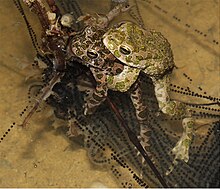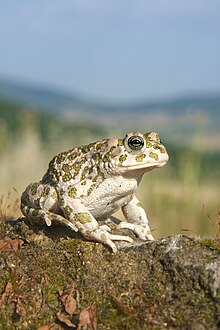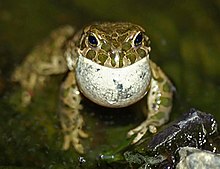European green toad
| European green toad | ||||||||||||
|---|---|---|---|---|---|---|---|---|---|---|---|---|

European green toad (from Russia; nominate form) |
||||||||||||
| Systematics | ||||||||||||
|
||||||||||||
| Scientific name | ||||||||||||
| Bufotes viridis | ||||||||||||
| ( Laurenti , 1768) |
The toad ( Bufotes viridis , Syn. : Bufo viridis occasionally Pseudepidalea viridis ), and Green toad called, is a Froschlurch from the genus Bufotes within the family of toads (bufonidae). According to today's view, it is not a single biological species, but a group of species from several evolutionary lines. In Europe alone, four different forms can be separated. The exact systematic position and delimitation of these taxa is currently still partly unclear.
features

The size of the males ranges up to eight, those of the females up to nine (ten) centimeters. While the basic color of the males is rather light gray, it is almost white in the females. Both are littered with green island spots (a bit more “washed out” in the male), which are only missing on the belly. There are mostly reddish warts on the flanks of the females. To interpret the name "European green toad", reference is made either to the changing pattern of spots or to the animals' ability to adapt their basic color from light to dark or vice versa, depending on the environment. The pupils are horizontal, the iris is lemon yellow to greenish. Like all real toads, it has ear glands ( parotid glands ) behind the eyes. There are many, not very pronounced warts on the top.
Reproduction
The fillet with a sound bladder , nocturnal mating call generated the male is sustained, not very long-range trilling ( "ürrr") that is gradually louder and higher. There are longer pauses between the trills. Often the reputation is confused with that of the mole cricket .
The spawning lines , which are often laid on the bottom of the water, are usually two to four meters long, depending on their stretch. The brown to black eggs lie in two to four rows in this gelatinous covering cord and can contain 2000 to a maximum of 15,000 pieces. Their diameter is between one and 1.5 millimeters.
The back coloration of the tadpoles is brownish to greenish-gray; their fin edges are light. Even before the metamorphosis , which takes place three to four months after hatching, an indistinct green pattern of spots is visible. At the end they reach a total length of up to 50 millimeters.
habitat
As an eastern steppe species and a Mediterranean element of fauna, the green toad is well adapted to dryness and warmth. It prefers open, sun-exposed, dry and warm habitats with burrowable soils and partly missing, gaps in grass and herb vegetation. It is therefore mainly to be found in ruderal locations , in dry fallow land in fields and in excavation areas. It is sometimes very far removed from open waters. Green toads are mainly nocturnal. The spawning waters are shallow and poor in vegetation, for example in stone quarries. Temporary waters with mineral soil are preferred as spawning waters. The green toad tolerates a slightly increased salinity of the spawning waters of more than ten per thousand. The larvae are also capable of development in brackish pools on the Baltic Sea. The ecological demands of the species are similar to those of the natterjack toad , which is more common in the Atlantic and western regions .
Distribution and Taxa
The species group of the Bufo viridis complex occurs continental-Mediterranean in Central Europe, in Southwest, South, Southeast and Eastern Europe, on many Mediterranean islands and as far as Central Asia and North Africa. The northernmost stocks in Europe are found on the southern tip of Sweden, on some Danish islands, as well as in Estonia and Russia. In Germany the green toad is only sparsely distributed and is absent in the entire northwest and in the extreme south, among other places. In Austria the main area of distribution is in Vienna, Lower Austria and Burgenland; the mountains are largely avoided.
There are currently four types of green toad in Europe:
- Bufotes viridis ( nominate form ; from the Rhineland in the west to western Russia in the east, northeast Italy, entire Balkan peninsula south to Crete, west and north of the Black Sea),
- The Balearic Green Toad ( Bufotes balearicus ) in Italy, Sardinia, Corsica and the Balearic Islands, where it was probably introduced by humans in the Bronze Age for mythological reasons.
- The North African green toad ( Bufotes boulengeri ) in North Africa, Sicily, Favignana , Ustica and Lampedusa .
- The Cypriot green toad ( Bufotes cypriensis ) in Cyprus.
There are also eleven purely Asian forms, some of which are hybridogenic hybrids .
The variable green toad ( Bufotes variabilis ) and the Sicilian green toad ( Bufotes siculus ) are no longer regarded as separate species but as synonyms of Bufotes viridis and Bufotes boulengeri .
The generic name Pseudepidalea used by some authors was discussed controversially, later the older scientific name Bufotes was introduced for this group. Nevertheless, the position as a separate genus was controversial, among other things with the reference that green toads can hybridize with natterjack toads (more rarely also common toads ) , but this should not be the case with representatives of different genera. Because of their monophyletic composition, the group around Bufotes viridis was accepted as a genus of its own.
Hazard and protection

As pioneering colonizers of arid biotopes with little vegetation with smaller, often sporadic water accumulations, green toads suffer from the lack of suitable spawning waters or from the fact that their habitats are covered with bushes and shaded. However, they are particularly affected by interventions such as the recultivation or conversion of fallow land and former excavation pits. Artificial fish stocking in small bodies of water also endangers some stocks.
Legal protection status (selection)
- Fauna-Flora-Habitat Directive (FFH-RL): Annex IV (species to be strictly protected)
- Federal Nature Conservation Act (BNatSchG): strictly protected
National Red List classifications (selection)
- Red List Federal Republic of Germany: 3 - endangered
- Red list of Austria: VU (corresponds to: endangered)
- Red list of Switzerland: RE (the species is extinct here)
literature
- Andreas Nöllert, Christel Nöllert: The amphibians of Europe. Franckh-Kosmos, Stuttgart 1992, ISBN 3-440-06340-2 .
Individual evidence
- ↑ a b Dufresnes, Mazepa, Jablonski, Oliveira, Wenseleers, Shabanov, Auer, Ernst, Koch, Ramírez-Chaves, Mulder, Simonovo, Tiutenko, Kryvokhyzhar, Wennekes, Zinenko, Korshunov, Al-Johany, Peregontsev, Masroor, Betto-Colliard , Denoël, Borkin, Skorinov, Pasynkova, Mazanaeva, Rosanov, Dubey and Litvinchuk (2019). Fifteen shades of green: The evolution of Bufotes toads revisited. Molecular Phylogenetics and Evolution. 141: 106615. doi: 10.1016 / j.ympev.2019.106615
- ↑ a b Dieter Glandt: Pocket dictionary of the amphibians and reptiles of Europe. Quelle & Meyer, Wiebelsheim 2010, ISBN 978-3-494-01470-8 .
- ↑ Klaus Lörcher, Hans Schneider: Comparative bio-acoustic studies on the natterjack toad, Bufo calamita (Laur.), And the green toad, Bufo v. viridis (Laur.). In: Zeitschrift für Tierpsychologie, Volume 32, 1973, pp. 506-521.
- ↑ Hans Schneider, Institute for Scientific Film: Bufo viridis (Bufonidae) - reputation behavior. Film E 2852 of the IWF, Göttingen 1989. Publication by Hans Schneider, Publication Scientific Film, Section Biology, Series 20, No. 17 / E 2852, 1990, 9 pages.
- ↑ Eviatar Nevo, Hans Schneider: Mating call pattern of green toads in Israel and its ecological correlate. Journal of Zoology, Volume 178, 1976, pp. 133-145.
- ^ Hans Schneider, Eduard M. Egiasarjan: The mating call of the green toad, Bufo viridis viridis (Anura, Amphibia) in Kazakhstan. In: Russian Journal of Herpetology, Volume 2, 1995. pp. 1-4.
- ↑ Hans Schneider: Bioacoustics of the Froschlurche - native and related species. With audio CD. Supplement to the Zeitschrift für Feldherpetologie 6. Laurenti Verlag, Bielefeld 2005. ISBN 3-933066-23-9 .
- ↑ Cristina Giacoma, Cinzia Zugolaro, Laura Beani: The advertisement calls of the green toad (Bufo viridis): variability and role in mate choice. In: Herpetologica 53, No. 4, 1997, pp. 454-464.
- ↑ a b Sergio Castellano, Luca Tontini, Cristina Ggiacoma, Aldo Lattes, Emilio Balletto: The evolution of release and advertisement calls in green toads (Bufo viridis complex). In: Biological Journal of the Linnean Society. 77, No. 3, 2002, pp. 379-391, doi: 10.1046 / j.1095-8312.2002.00118.x .
- ↑ Helmut Hemmer, Beate Kadel, Karl Kadel (1981). The Balearic toad (Bufo viridis balearicus (BOETTGER, 1881)), human bronze age culture, and Mediterranean biogeography . Amphibia reptilia. 2 (3): 217-230. doi: 10.1163 / 156853881X00041
- ^ Bufotes at Amphibiaweb.org
- ^ Bufotes at Amphibians of the world.org
- ^ RA Pyron, JJ Wiens: A large-scale phylogeny of Amphibia including over 2800 species, and a revised classification of extant frogs, salamanders, and caecilians. Molecular Phylogenetics and Evolution, 61, 2, pp. 543-583, November 2011
- ^ European green toad at www.wisia.de
- ↑ Federal Agency for Nature Conservation (ed.): Red list of endangered animals, plants and fungi in Germany 1: Vertebrates. Landwirtschaftsverlag, Münster 2009, ISBN 978-3-7843-5033-2 .
- ↑ Online overview at www.amphibienschutz.de
further reading
- C. Colliard, A. Sicilia, GF Turrisi, M. Arculeo, N. Perrin, M. Stöck: Strong reproductive barriers in a narrow hybrid zone of West-Mediterranean green toads (Bufo viridis subgroup) with Plio-Pleistocene divergence. In: BMC Evolutionary Biology. 10, 2010, p. 232. ( article online ).
- M. Stöck, C. Moritz, M. Hickerson, D. Frynta, T. Dujsebayeva, V. Eremchenko, JR Macey, TJ Papenfuss, DB Wake: Evolution of mitochondrial relationships and biogeography of Palearctic green toads (Bufo viridis subgroup) with insights in their genomic plasticity. In: Molecular Phylogenetics and Evolution. 41, 2006, pp. 663-689.
- M. Stöck, A. Sicilia, N. Belfiore, D. Buckley, S. Lo Brutto, M. Lo Valvo, M. Arculeo: Post-Messinian evolutionary relationships across the Sicilian channel: Mitochondrial and nuclear markers link a new green toad from Sicily to African relatives. In: BMC Evol. Biol. 56, 2008, p. 8. ( article online ).
- M. Stöck, P. Roth, R. Podloucky, K. Grossenbacher: Green toads - taking into account Bufo viridis viridis Laurenti, 1768; Bufo variabilis (Pallas, 1769); Bufo boulengeri Lataste, 1879; Bufo balearicus Böttger, 1880 and Bufo siculus Stöck, Sicilia, Belfiore, Buckley, Lo Brutto, Lo Valvo & Arculeo, 2008. In: K. Grossenbacher (Ed.): Handbuch der Amphibien und Reptilien Europa. Vol. 5 (Froschlurche II) [Handbook of the Amphibians and Reptiles of Europe. vol. 5 (Anura II)]. Aula-Verlag, Wiesbaden 2009, pp. 413–498.
Web links
- Darrel R. Frost: Bufotes viridis , Amphibian Species of the World, Version 6.0, American Museum of Natural History, 1998-2014, accessed April 24, 2014
- Photos of the green toad at www.herp.it
- Information with photo at www.herpetofauna.at
- Video of a male calling
- IUCN Redlist: Entry on Pseudepidalea balearica , Pseudepidalea boulengeri , Pseudepidalea sicula , Pseudepidalea turanensis , Pseudepidalea variabilis , Pseudepidalea viridis



